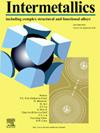Optimization of CuMnNiSnSi medium-entropy bronze alloys via solution-aging treatment: Tribological behavior under starved oil lubrication and dry sliding
IF 4.8
2区 材料科学
Q2 CHEMISTRY, PHYSICAL
引用次数: 0
Abstract
The (CuMnNiSn)100-xSix (x = 2, 4, and 6 in molar ratio) medium-entropy bronze alloys were subjected to solution-aging treatment to refine the microstructure and reduce compositional segregation. The effects of Si content and the solution-aging treatment on the microstructure and mechanical properties were systematically investigated. The tribological behavior of the treated CuMnNiSn)100-xSix alloys under starved oil lubrication and dry sliding conditions was analyzed. As the Si content increases to 4 at.%, the precipitation of rod-like (Mn,Ni)3Si intermetallic compound within the face-centered cubic (FCC) matrix gives rise to significant hardening in the alloy. The solution-aging treatment contributes to the alloy's ductility and fracture toughness by enhancing compositional homogeneity while reducing the content of brittle phases. As the Si content increased from 2 to 6 at.%, the wear rate of the treated alloys monotonically decreased from 5.22 × 10−7 to 1.28 × 10−7 mm3 N−1 m−1 under starved oil lubrication conditions and from 5.32 × 10−5 to 1.08 × 10−5 mm3 N−1 m−1 under dry sliding conditions. The treated (CuMnNiSn)94Si6 alloy exhibited a threefold improvement in wear resistance compared to the treated (CuMnNiSn)98Si2 alloy under starved oil lubrication conditions. This improvement further increased fourfold under dry sliding conditions, due to the formation of a locally-protective glaze layer (composed of SnO2 and SiO2) on the worn surface.
通过固溶时效处理优化CuMnNiSnSi中熵青铜合金:缺油润滑和干滑动下的摩擦学行为
对(CuMnNiSn)100- x6 (x = 2、4和6的摩尔比)中熵青铜合金进行固溶时效处理,以细化组织,减少成分偏析。系统研究了Si含量和固溶时效处理对合金组织和力学性能的影响。分析了处理后的CuMnNiSn 100- x6合金在缺油润滑和干滑动条件下的摩擦学行为。随着Si含量增加到4at。%,在面心立方(FCC)基体中析出棒状(Mn,Ni)3Si金属间化合物,导致合金明显硬化。固溶时效处理提高了合金的成分均匀性,降低了脆性相的含量,提高了合金的塑性和断裂韧性。随着Si含量由2 ~ 6 at增加。在干滑动条件下,合金的磨损率从5.32 × 10−5下降到1.08 × 10−5 mm3 N−1 m−1,在缺油润滑条件下,合金的磨损率从5.22 × 10−7单调下降到1.28 × 10−7 mm3 N−1 m−1。在缺油润滑条件下,经过处理的(cumnisn)94Si6合金的耐磨性比经过处理的(cumnisn)98Si2合金提高了3倍。在干滑动条件下,由于在磨损表面形成了局部保护釉层(由SnO2和SiO2组成),这种改善进一步增加了四倍。
本文章由计算机程序翻译,如有差异,请以英文原文为准。
求助全文
约1分钟内获得全文
求助全文
来源期刊

Intermetallics
工程技术-材料科学:综合
CiteScore
7.80
自引率
9.10%
发文量
291
审稿时长
37 days
期刊介绍:
This journal is a platform for publishing innovative research and overviews for advancing our understanding of the structure, property, and functionality of complex metallic alloys, including intermetallics, metallic glasses, and high entropy alloys.
The journal reports the science and engineering of metallic materials in the following aspects:
Theories and experiments which address the relationship between property and structure in all length scales.
Physical modeling and numerical simulations which provide a comprehensive understanding of experimental observations.
Stimulated methodologies to characterize the structure and chemistry of materials that correlate the properties.
Technological applications resulting from the understanding of property-structure relationship in materials.
Novel and cutting-edge results warranting rapid communication.
The journal also publishes special issues on selected topics and overviews by invitation only.
 求助内容:
求助内容: 应助结果提醒方式:
应助结果提醒方式:


